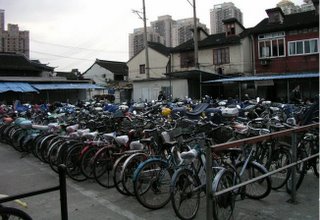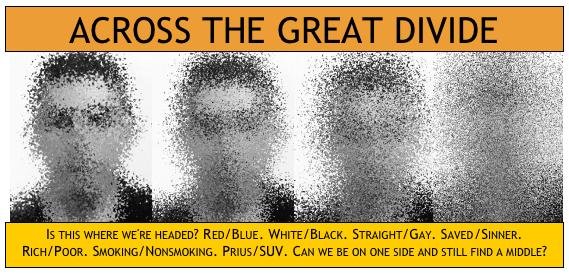Can the World Afford Two Beautiful Countries?
Troutsky asks in a comment on the previous post, "Is growth truly something which can be perpetually sustained, for eternity?"
There are at least two possible answers to this.
One is "yes." This is likely to come from someone who is optimistic about technology, dedicated to self-interest, and really has no expectation of actually being around when the final answer comes down.
The other is "no." It usually comes from the few who have rejected the short-sighted allure of consumerism and the many more who have already got theirs and now want to keep out the riff raff. Either way, that "no" begs the question of how you stop the comfortable lifestyle train without derailing it. Right now, Al Qaida and the Taliban seem to be the only ones intent on stopping western-style growth, and I don't care for their solution.
We are accustomed to holding America's consumption responsible for the planet's environmental peril, but that's a petty misdemeanor compared to our complicity in setting a bad example for the developing world.
In the introductory Chinese lesson during our tour, we were told that the Chinese ideograph for America could be translated as "Beautiful Country." That's kind of sweet until you realize how they are starting to emulate American-style growth. If they succeed, we are all in deep doo-doo.
 One question I heard several times after returning was: "Were there lots of bikes in Beijing?"
One question I heard several times after returning was: "Were there lots of bikes in Beijing?"
By U.S. standards, certainly. But bike-clogged streets are an old movie. The really striking impressions were of the number of autos and the amount of construction in every city. China is already reportedly the leading buyer of steel and concrete. With its huge trade surplus, China holds a large amount of U.S. Treasuries, and therefore, exerts significant influence over U.S. interest rates. It is only a matter of time before China becomes the leading customer for the world's oil.
Building weapons of mass destruction and sending troops around the world is so-o-o old economy.
The oil gap between China and the U.S. is still wide. Our 300 million people manage to consume 20.5 million barrels of crude oil per day, while China's 1.3 billion get by on only 6.5 million per day. U.S. citizens own roughly 0.6 cars per capita. In China, as of 2003, the ownership rate was only about 0.0054 per capita, but the percentage had grown 134% from 1998. It shows little sign of slowing, despite government efforts to discourage ownership by making driver's licenses difficult to obtain and license plates as costly as a used car.
It's not hard to imagine China, with its ascendant economy, soon reaching Mexico's level of car ownership (0.1 per capita), which would mean it had put nearly as many cars on the road as in America. Throw in the increased demand on China's coal-fired power plants, which contribute to perpetual smog and streak even the new buildings with Industrial Revolution grime, and you can almost hear the polar ice cap melting from here. Even more immediately disturbing, after a week in the country, we realized the only birds we'd seen in China were in cages — or barbequed on sticks.
Still more worrisome for us than the environmental degradation, I think, is the slurping sound as another large economy pokes its straw into the earth's communal petro shake.
The Chinese government has enforced strict population limits and still controls some brakes on the economy. But it's hard to see the forces of reform and openness being reversed. People want better lives, and when you live in the land of second cars and second homes, it's hard to deny others a quarter of what we have.
But can the planet afford more than one beautiful country? And if only one, whose will it be?
There are at least two possible answers to this.
One is "yes." This is likely to come from someone who is optimistic about technology, dedicated to self-interest, and really has no expectation of actually being around when the final answer comes down.
The other is "no." It usually comes from the few who have rejected the short-sighted allure of consumerism and the many more who have already got theirs and now want to keep out the riff raff. Either way, that "no" begs the question of how you stop the comfortable lifestyle train without derailing it. Right now, Al Qaida and the Taliban seem to be the only ones intent on stopping western-style growth, and I don't care for their solution.
We are accustomed to holding America's consumption responsible for the planet's environmental peril, but that's a petty misdemeanor compared to our complicity in setting a bad example for the developing world.
In the introductory Chinese lesson during our tour, we were told that the Chinese ideograph for America could be translated as "Beautiful Country." That's kind of sweet until you realize how they are starting to emulate American-style growth. If they succeed, we are all in deep doo-doo.
 One question I heard several times after returning was: "Were there lots of bikes in Beijing?"
One question I heard several times after returning was: "Were there lots of bikes in Beijing?"By U.S. standards, certainly. But bike-clogged streets are an old movie. The really striking impressions were of the number of autos and the amount of construction in every city. China is already reportedly the leading buyer of steel and concrete. With its huge trade surplus, China holds a large amount of U.S. Treasuries, and therefore, exerts significant influence over U.S. interest rates. It is only a matter of time before China becomes the leading customer for the world's oil.
Building weapons of mass destruction and sending troops around the world is so-o-o old economy.
The oil gap between China and the U.S. is still wide. Our 300 million people manage to consume 20.5 million barrels of crude oil per day, while China's 1.3 billion get by on only 6.5 million per day. U.S. citizens own roughly 0.6 cars per capita. In China, as of 2003, the ownership rate was only about 0.0054 per capita, but the percentage had grown 134% from 1998. It shows little sign of slowing, despite government efforts to discourage ownership by making driver's licenses difficult to obtain and license plates as costly as a used car.
It's not hard to imagine China, with its ascendant economy, soon reaching Mexico's level of car ownership (0.1 per capita), which would mean it had put nearly as many cars on the road as in America. Throw in the increased demand on China's coal-fired power plants, which contribute to perpetual smog and streak even the new buildings with Industrial Revolution grime, and you can almost hear the polar ice cap melting from here. Even more immediately disturbing, after a week in the country, we realized the only birds we'd seen in China were in cages — or barbequed on sticks.
Still more worrisome for us than the environmental degradation, I think, is the slurping sound as another large economy pokes its straw into the earth's communal petro shake.
The Chinese government has enforced strict population limits and still controls some brakes on the economy. But it's hard to see the forces of reform and openness being reversed. People want better lives, and when you live in the land of second cars and second homes, it's hard to deny others a quarter of what we have.
But can the planet afford more than one beautiful country? And if only one, whose will it be?




0 Comments:
Post a Comment
<< Home